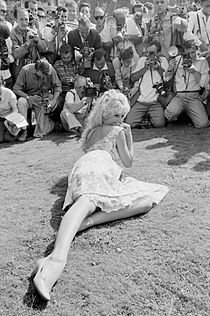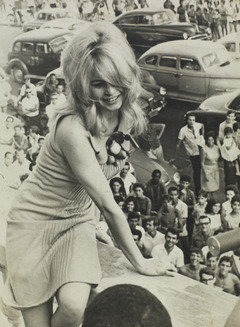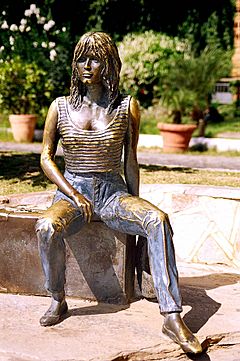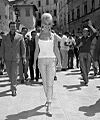Brigitte Bardot facts for kids
Quick facts for kids
Brigitte Bardot
|
|
|---|---|

Bardot in a publicity photo for A Very Private Affair (1962)
|
|
| Born |
Brigitte Anne-Marie Bardot
28 September 1934 |
| Occupation |
|
| Years active | 1952–1973 (entertainer) 1973–present (activist) |
|
Works
|
|
| Political party | National Rally |
| Spouse(s) |
Jacques Charrier
(m. 1959; div. 1962)Gunter Sachs
(m. 1966; div. 1969)Bernard d'Ormale
(m. 1992) |
| Children | 1 |
| Relatives | Mijanou Bardot (sister) |
| Signature | |
Brigitte Anne-Marie Bardot (born 28 September 1934), often known by her initials B.B., is a French actress, singer, and animal rights activist. She was one of the most famous stars of the 1950s and 1960s. She was known for playing free-spirited characters and became a symbol of a new, modern style.
Bardot starred in 47 films and recorded over 60 songs. In 1973, she retired from the movie industry to spend her life helping animals. Even after leaving acting, she has remained a famous pop culture icon. For her work, she was awarded the Legion of Honour, one of France's highest awards, in 1985.
Contents
Early Life and First Steps in Modeling
Brigitte Bardot was born in Paris, France, to Louis Bardot and Anne-Marie Mucel. Her father was an engineer who owned factories, and her family was well-off. She grew up in a large apartment in a nice part of Paris. She has one younger sister, Mijanou Bardot.
As a child, Bardot dreamed of becoming a ballerina. Her mother encouraged this and signed her up for dance lessons. In 1949, at age 14, she was accepted into the famous Conservatoire de Paris to study ballet with Russian choreographer Boris Knyazev.
Her career began when she was hired as a model for Elle magazine. On 8 March 1950, the 15-year-old Bardot appeared on the cover of Elle. This led to an offer for a movie role. At the audition, she met director Roger Vadim. Although she didn't get the part, they fell in love. Her parents did not approve of the relationship at first, but they later agreed on the condition that Bardot would marry Vadim when she turned 18.
A Career in Movies and Music
Her First Films
In 1952, Bardot appeared on the cover of Elle again. This got her a part in the comedy film Crazy for Love. She then had roles in other French films like Manina, the Girl in the Bikini (1952) and His Father's Portrait (1953).
She also had a small role in the American movie Act of Love, which was filmed in Paris and starred Kirk Douglas. She started to get more attention from the media, especially at the Cannes Film Festival.
Bardot played her first big role in an English-language film in Doctor at Sea (1955). The movie was a huge hit in Britain. For the Italian movie Nero's Weekend (1956), she was asked to appear as a blonde. She dyed her hair and liked it so much that she kept the color, which became part of her famous look.
Becoming a Global Star

Bardot became a huge star after the movie And God Created Woman (1956). The film was directed by her husband at the time, Roger Vadim. It was a major success in France and all over the world. It made Bardot an international celebrity.
She then starred in several other successful movies, including La Parisienne (1957) with actor Charles Boyer, and In Case of Adversity (1958). By 1958, she was the highest-paid actress in France.
Her 1960 film, The Truth, was a big commercial success and was nominated for an Academy Award. For her role, Bardot won a David di Donatello Award for Best Foreign Actress.
International Fame and Singing
In the 1960s, Bardot starred in more international films. She worked with famous director Jean-Luc Godard on the film Le Mépris (1963). She also starred in the Western comedy Viva Maria! (1965) with actress Jeanne Moreau. The film was a big hit worldwide.
Besides acting, Bardot also had a successful singing career. She recorded many popular songs, often with French musician Serge Gainsbourg. Some of her famous songs include "Harley Davidson," "La Madrague," and "Contact."
Final Films
From 1969 to 1972, Bardot was chosen as the face of Marianne, the symbol of France. This was a great honor, as Marianne represents the liberty of the French Republic.
Her last few films were mostly comedies, like The Bear and the Doll (1970) and The Legend of Frenchie King (1971). In 1973, after finishing the film The Edifying and Joyous Story of Colinot, Bardot announced her retirement from acting. She said she wanted to "get out elegantly" and focus on other things.
A Life Dedicated to Animal Rights
After retiring, Bardot dedicated her life to helping animals. In 1986, she created the Brigitte Bardot Foundation for the Welfare and Protection of Animals. To raise money for the foundation, she auctioned off her jewelry and other personal items.
She became a strong voice against eating horse meat and has campaigned to protect many different animals.
- Seal Pups: In 1977, she traveled to Canada to protest the hunting of seal pups. Photos of her with the baby seals were seen around the world and brought attention to the issue.
- Stray Dogs: She donated over $140,000 to help sterilize and find homes for the many stray dogs in Bucharest, Romania.
- Dolphins: In 2010, she wrote to the Queen of Denmark, asking her to help stop the killing of dolphins in the Faroe Islands.
- Bullfighting: She has been a strong critic of bullfighting and protested when it was added to France's cultural heritage list in 2011.
In appreciation of her support, the Sea Shepherd Conservation Society named one of its ships the MV Brigitte Bardot. Her foundation continues to work on animal welfare projects around the world.
Personal Life
Brigitte Bardot has been married four times. Her first marriage was to director Roger Vadim in 1952. She later married actor Jacques Charrier in 1959, and they had one son, Nicolas-Jacques Charrier. Her third husband was German millionaire Gunter Sachs.
Since 1992, she has been married to Bernard d'Ormale.
Bardot has always been known for her strong personality and for speaking her mind. She has been involved in some controversies because of her outspoken views on political and social issues in France.
Legacy and Influence
Brigitte Bardot is remembered as a major style icon. She popularized several fashion trends:
- The Bardot Neckline: A wide-open neckline that shows both shoulders is named after her.
- The Bikini: She helped make the bikini popular around the world through her films and photos.
- Gingham Fabric: She wore a pink and white checkered dress at her wedding to Jacques Charrier, which made the fabric very fashionable.
- The "Choucroute" Hairstyle: A hairstyle similar to the beehive, which many women copied.
She also helped make the French town of Saint-Tropez a famous tourist destination. A town in Brazil, Armação dos Búzios, also became popular after she visited in 1964. There is even a statue of her there.
Many famous people have been inspired by Bardot, including musicians like John Lennon and Bob Dylan. Her look has been copied by many models and actresses over the years, such as Claudia Schiffer and Scarlett Johansson. In 2020, Vogue magazine named her the most beautiful French actress of all time.
Images for kids
-
Brigitte Bardot and Michel Piccoli caught by paparazzi in Italy during the filming of Contempt in 1963
See also
 In Spanish: Brigitte Bardot para niños
In Spanish: Brigitte Bardot para niños
- Brigitte Bardot
- List of animal rights advocates













